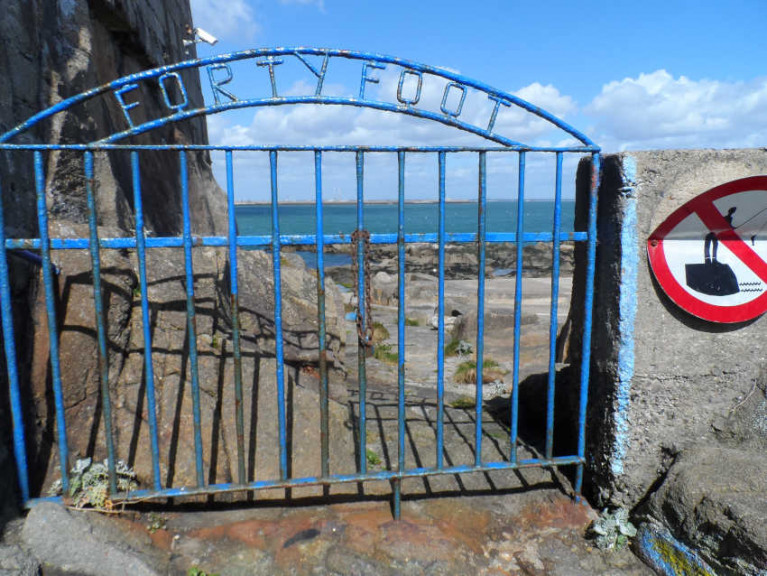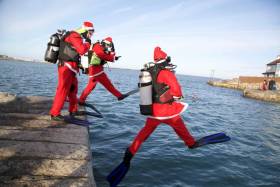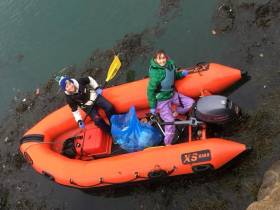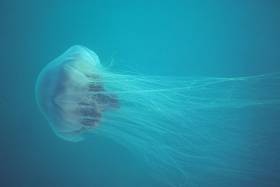Displaying items by tag: Sandycove
Renowned Property Overlooking Famous ‘Forty Foot’ Swimming Spot Is Sold to Irish Buyer
The storied Battery above the Forty Foot in Sandycove has a new owner, as The Irish Times reports.
With a price tag of €3 million, the three-bedroom home created on the site of a former Dublin Bay military installation was sold this past July to an Irish buyer, a year after it was put on the market.
At the time, the move prompted a local campaign calling on Dun Laoghaire-Rathdown County Council to buy the property to “provide space and facilities” for bathers at the famed swimming spot while also “serving to protect our historical and architectural heritage”, as previously reported on Afloat.ie.
But even the new owner will have to abide by the rules of the architectural conservation area in which the Battery is situated, not to mention that its boundary wall is a protected structue.
The Irish Times has more on the story HERE.
Online Petition Calls on Local Authority to Buy Storied Property Overlooking Famous ‘Forty Foot’ Swimming Spot
More than 400 people have signed a petition calling on Dun Laoghaire-Rathdown County Council to buy the Battery above the Forty Foot in Sandycove.
The three-bedroom home created on the site of a former Dublin Bay military installation has been on the market since last month with a price tag of €3 million, as Irish Times Property reports.
Local campaigners have put up posters locally with a link to their petition, which suggests that DLRCoCo could purchase the property to “provide space and facilities” for bathers at the famed swimming spot, while also “serving to protect our historical and architectural heritage”.
 The Battery with its old fortifications next to the famed Forty Foot swimming hole | Credit: Lisney Sotheby’s International Realty Dalkey
The Battery with its old fortifications next to the famed Forty Foot swimming hole | Credit: Lisney Sotheby’s International Realty Dalkey
Built from Dalkey granite, the Battery has a military history that extends from the early 1800s until the Emergency during the Second World War. It passed from State hands into private ownership in 1955, when it was subsequently transformed into a characterful family home.
The campaign says: “We have a wonderful opportunity to return the Battery to public ownership and for the council to acquire the space it needs to develop vital facilities, meet its own objectives for creating suitable outdoor amenities that promote community health and wellbeing and to preserve and protect our architectural and historical heritage and our environment.”
 One of the posters taped up locally with a link to the petition | Credit: Afloat.ie
One of the posters taped up locally with a link to the petition | Credit: Afloat.ie
Despite the Forty Foot’s enduring popularity for bathers, campaigners point out that it “lacks many basic facilities” such as a dedicated lifeguard station with first aid, toilets and showers, drinking water and a “warm safe space” for cold-water swimmers.
For more on the campaign, see the petition on Change.org.
Forty Foot & Other Dublin Bay Bathing Spots Closed To Public Over Social Distancing Concerns
Popular bathing spots at the Forty Foot, Sandycove and Seapoint on Dublin Bay have been closed as of today (Saturday 11 April) following the latest extension of restrictions against Covid-19.
Dun Laoghaire-Rathdown County Council said the decision was made “following consultation [with] the Garda, as a result of concerns raised with social distancing compliance”.
All three bathing areas are now closed to the public until further notice, following the announcement that movement restrictions amid the Covid-19 pandemic have been extended to Tuesday 5 May.
It follows a nationwide call on Thursday by the Coastguard and the RNLI asking people not to use the sea for exercise or recreation.
Santa Scuba Dive Takes The Plunge For Lifeboats In Sandycove This Weekend
Tomorrow at noon (Sunday 15 December) Scuba divers dressed in Santa suits will be ready to dive into the sea water off Sandycove for the annual Santa Scuba Dive.
This unique Christmas event has raised over €12,000 for the RNLI since it was started in 2014 by Karen Kenny of the Dublin University Sub Aqua Club.
Divers will enter the water at 1pm, and spectators will also see the local D-class lifeboat and Howth Coast Guard RIB and a flyby from the Dublin-based coastguard helicopter, weather and operations permitting.
For more see the event page on Facebook and the fundraising page on JustGiving.
Plastic fibres released during construction on the Dun Laoghaire baths site last year have again washed up on nearby beaches, as The Irish Times reports.
The plastic shards were washed into the water during a concrete pour at the development last November, prompting a safety advisory for swimmers and beach-goers between the West Pier and the Forty Foot.
A clean-up operation was launched at the time which recovered 50kg of the 70kg of plastic strands released.
Now a volunteer clean-up group says some of the unrecovered plastic reappeared at Sandycove on Thursday ahead of Storm Lorenzo.
The Irish Times has more on the story HERE.
Dublin Bay Live Webcam: Big Waves at Dun Laoghaire
As another weather system ahead of Hurricane Lorenzo starts to makes its presence felt on the Irish East coast today, below is the current scene at Dun Laoghaire on Dublin Bay viewed northwards from Sandycove on this Dun Laoghaire Harbour and Sandycove webcam.
Met Eireann has said there is still some uncertainty over the future path of Hurricane Lorenzo, but it expects to have more precise details tomorrow. The forecaster has been working with the US National Hurricane Center and others to try and predict the storm's route. Met Eireann's Jean Byrne said: "The closer we get to the event, obviously, the better idea we should have. Luckily the models are coming in a little bit more into line, so I think we are fairly confident at this stage it will track close to Ireland, at least, if not over it.
High Water at Dun Laoghaire is 2pm
Lion’s Mane Jellyfish Spotted Off Sandycove Prompt Vigilance
Dun Laoghaire-Rathdown County Council has put up warning signs in the lifeguarded area of Sandycove in south Dublin after sightings of lion’s mane jellyfish in the water.
Though the notice was put in place yesterday (Thursday 13 June), it’s emerged there have been sightings of the venomous marine wildlife since mid-May.
Bathing has not been prohibited as it was with the water quality warning earlier this month.
But swimmers at Sandycove and further out in Dublin Bay are advised to proceed with caution for the time being.
As an added precaution the lifeguard warning flags are on red and will remain in place till further notice, the council says.
Lion’s mane jellyfish carry a painful and potentially lethal sting, even when washed up on the beach.
Last summer saw more than 150 lion's mane jellyfish recorded along the West Coast — amid a spate of incidents with swimmers being stung in Galway Bay.
But the East Coast was not immune, as a teenager was hospitalised after he was stung over most of his body off a Co Louth beach.
Sandycove Beach Ho-Ho-Hosting Santa Scuba Dive This Weekend To Raise Funds For Lifeboat Charity
This Saturday morning (22 December) 100 Scuba divers dressed in Santa suits will brave the elements and dive into the sea water off Sandycove Beach to raise money for the RNLI.
The annual Santa Scuba Dive has raised over €8,000 since 2014 when it was started by Karen Kenny of the Dublin University Sub-Aqua Club.
The unique Christmas event begins at 11am this Saturday 22 December at Sandycove Beach in Dun Laoghaire, Co Dublin — and spectators will also see the local D-class lifeboat, Howth Coast Guard RIB and a flyby from the Dublin-based coastguard helicopter, weather and operations permitting.
For more see the event page on Facebook and the fundraising page on JustGiving.
How One Girl Is Leading The Fight Against Litter In Dublin Bay
#DublinBay - Litter in the water is a longstanding issue in Dun Laoghaire and Sandycove — but one local schoolgirl has taken it upon herself to do something about it.
Ten-year-old Flossie Donnelly started this past summer calling for volunteers to help clean up the sea shore at Sandycove every Friday evening, even designing her own poster to spread the word on social media and around the neighbourhood.
On her blog, Flossie writes that she was “really sad” that no one came to her first clean-up.
But a meeting at the Forty Foot the next day with county councillor Cormac Devlin led to the word spreading further in the local press.
“It’s very unusual that a child of her age approached an adult and a politician at that. That she is so environmentally aware is wonderful,” Cllr Devlin told the Dublin People in August.
By the end of the summer, Flossie was in charge of her own crew of volunteers helping to remove plastic debris that is dangerous to Dublin Bay’s marine life and local boaters alike.
Despite the shorter days and colder weather of late autumn and winter, Flossie is still leading regular coastal clean-ups and making friends along the way — including an Australian girl whose message she found in a bottle.
 Marine debris in Dun Laoghaire
Marine debris in Dun Laoghaire
More recently, Flossie was out on a RIB in Dun Laoghaire Harbour to clean up the breakwaters — filling three boats with rubbish and doing “a week’s work in a day”, according to Dun Laoghaire Coast Guard, who praised the “inspirational” girl for her efforts.
But the ambitious youngster isn’t stopping there, with plans to raise money for the installation of a Seabin automated cleaning system for the harbour, in what would be a first for Ireland.
Previously highlighted during Afloat.ie’s Rio Olympics coverage last year, the Seabin device has the potential to collect as many as 83,000 plastic bags or 20,000 plastic bottles each year.
That amounts to half a tonne of plastic annually, from visible debris to micro-plastics that threaten our protected species.
Britain’s first Seabin was recently installed at the pontoon of America’s Cup team Land Rover BAR in Portsmouth as part of a project to restore populations of oysters in the Solent.
Flossie and her beach cleaning squad will be hosting a table quiz at Fitzgerald’s Pub in Sandycove next Thursday 30 November to raise funds towards Dublin Bay’s first Seabin. For details see Flossie’s website HERE.
Lion’s Mane Jellyfish Warning For Dublin Bay
#Jellyfish - Swimmers have been warned away from Seapoint and Sandycove on the south shores of Dublin Bay after sightings of potentially dangerous lion’s mane jellyfish in the water.
Dun Laoghaire-Rathdown County Council has put up warning signs in the relevant areas to advise the public on the large jellyfish, whose stings from hundreds of tentacles can cause anaphylactic shock — even many days after they have beached.































































